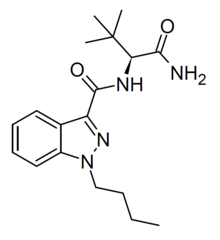 | |
| Legal status | |
|---|---|
| Legal status |
|
| Identifiers | |
| |
| CAS Number | |
| PubChem CID | |
| ChemSpider | |
| UNII | |
| ChEMBL | |
| Chemical and physical data | |
| Formula | C18H26N4O2 |
| Molar mass | 330.432 g·mol−1 |
| 3D model (JSmol) | |
| |
| |
ADB-BUTINACA (also known as ADMB-BINACA using EMCDDA naming standards[3]) is a synthetic cannabinoid compound which has been sold as a designer drug.[4][5][6][7][8] It is a potent CB1 agonist, with a binding affinity of 0.29nM for CB1 and 0.91nM for CB2, and an EC50 of 6.36 nM for CB1.[9][10][11][12][13][14][15]
See also[edit]
References[edit]
- ^ Anvisa (2023-03-31). "RDC Nº 784 - Listas de Substâncias Entorpecentes, Psicotrópicas, Precursoras e Outras sob Controle Especial" [Collegiate Board Resolution No. 784 - Lists of Narcotic, Psychotropic, Precursor, and Other Substances under Special Control] (in Brazilian Portuguese). Diário Oficial da União (published 2023-04-04). Archived from the original on 2023-08-03. Retrieved 2023-08-15.
- ^ "Substance Details ADB-BUTINACA". Retrieved 2024-01-22.
- ^ Pulver, Benedikt; Fischmann, Svenja; Gallegos, Ana; Christie, Rachel (March 2023). "EMCDDA framework and practical guidance for naming synthetic cannabinoids". Drug Testing and Analysis. 15 (3): 255–276. doi:10.1002/dta.3403.
- ^ Kavanagh P, Pechnikov A, Nikolaev I, Dowling G, Kolosova M, Grigoryev A (July 2022). "Detection of ADB-BUTINACA Metabolites in Human Urine, Blood, Kidney and Liver". Journal of Analytical Toxicology. 46 (6): 641–650. doi:10.1093/jat/bkab088. PMID 34341821.
- ^ Sia CH, Wang Z, Goh EM, Tan YL, Fong CY, Moy HY, Chan EC (November 2021). "Urinary Metabolite Biomarkers for the Detection of Synthetic Cannabinoid ADB-BUTINACA Abuse". Clinical Chemistry. 67 (11): 1534–1544. doi:10.1093/clinchem/hvab134. PMID 34387654.
- ^ Kronstrand R, Norman C, Vikingsson S, Biemans A, Valencia Crespo B, Edwards D, et al. (April 2022). "The metabolism of the synthetic cannabinoids ADB-BUTINACA and ADB-4en-PINACA and their detection in forensic toxicology casework and infused papers seized in prisons". Drug Testing and Analysis. 14 (4): 634–652. doi:10.1002/dta.3203. PMID 34811926. S2CID 244490343.
- ^ Wang Y, Pan Y, Yang H, Liu J, Wurita A, Hasegawa K (July 2022). "Quantification of MDMB-4en-PINACA and ADB-BUTINACA in human hair by gas chromatography-tandem mass spectrometry". Forensic Toxicology. 40 (2): 340–348. doi:10.1007/s11419-022-00615-z. PMID 36454410. S2CID 247501663.
- ^ King A, Hill SL, Pucci M, Bailey G, Keating L, Macfarlane R, et al. (October 2022). "Clinical features associated with ADB-BUTINACA exposure in patients attending emergency departments in England". Clinical Toxicology. 60 (10): 1094–1098. doi:10.1080/15563650.2022.2101469. PMID 35943421. S2CID 251444625.
- ^ https://cdn.who.int/media/docs/default-source/controlled-substances/45th-ecdd/adb-butinaca_draft.pdf
- ^ Cannaert A, Sparkes E, Pike E, Luo JL, Fang A, Kevin RC, et al. (December 2020). "Synthesis and in Vitro Cannabinoid Receptor 1 Activity of Recently Detected Synthetic Cannabinoids 4F-MDMB-BICA, 5F-MPP-PICA, MMB-4en-PICA, CUMYL-CBMICA, ADB-BINACA, APP-BINACA, 4F-MDMB-BINACA, MDMB-4en-PINACA, A-CHMINACA, 5F-AB-P7AICA, 5F-MDMB-P7AICA, and 5F-AP7AICA". ACS Chemical Neuroscience. 11 (24): 4434–4446. doi:10.1021/acschemneuro.0c00644. PMID 33253529. S2CID 227246346.
- ^ Pike E, Grafinger KE, Cannaert A, Ametovski A, Luo JL, Sparkes E, et al. (July 2021). "Systematic evaluation of a panel of 30 synthetic cannabinoid receptor agonists structurally related to MMB-4en-PICA, MDMB-4en-PINACA, ADB-4en-PINACA, and MMB-4CN-BUTINACA using a combination of binding and different CB1 receptor activation assays: Part I-Synthesis, analytical characterization, and binding affinity for human CB1 receptors". Drug Testing and Analysis. 13 (7): 1383–1401. doi:10.1002/dta.3037. PMID 33787091.
- ^ Sparkes E, Cairns EA, Kevin RC, Lai F, Grafinger KE, Chen S, et al. (February 2022). "Structure-activity relationships of valine, tert-leucine, and phenylalanine amino acid-derived synthetic cannabinoid receptor agonists related to ADB-BUTINACA, APP-BUTINACA, and ADB-P7AICA". RSC Medicinal Chemistry. 13 (2): 156–174. doi:10.1039/D1MD00242B. PMC 8864554. PMID 35308023. S2CID 239951357.
- ^ Fan X, Zhang J, Fu X, Zhou B, Xu Z, Huang H, et al. (June 2022). "Analysis of synthetic cannabinoids in wastewater of major cities in China". The Science of the Total Environment. 827: 154267. Bibcode:2022ScTEn.827o4267F. doi:10.1016/j.scitotenv.2022.154267. PMID 35247413. S2CID 247244155.
- ^ Bäckberg M, Vikingsson S, Strandberg J, Wall S, Åstrand A, Karlsson H, et al. (July 2023). "Using in vitro receptor activity studies of synthetic cannabinoids to support the risk assessment of new psychoactive substances - A Swedish strategy to protect public health from harm". Forensic Science International. 348: 111691. doi:10.1016/j.forsciint.2023.111691. PMID 37116244. S2CID 258152652.
- ^ Tokarczyk B, Suchan M, Adamowicz P (March 2023). "New Synthetic Cannabinoid ADB-BUTINACA-Related Death of a Police Dog". Journal of Analytical Toxicology. 47 (2): e23–e28. doi:10.1093/jat/bkac097. PMID 36472351.